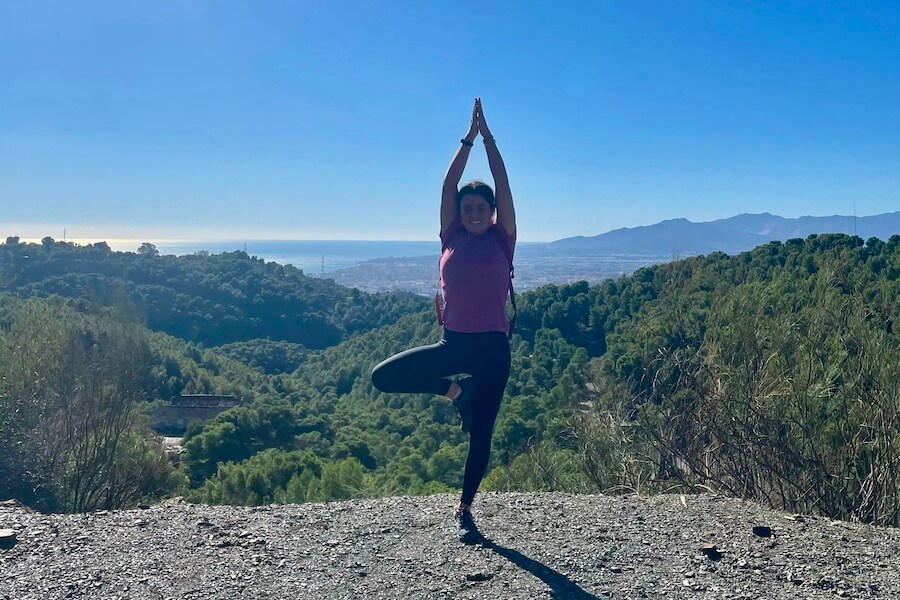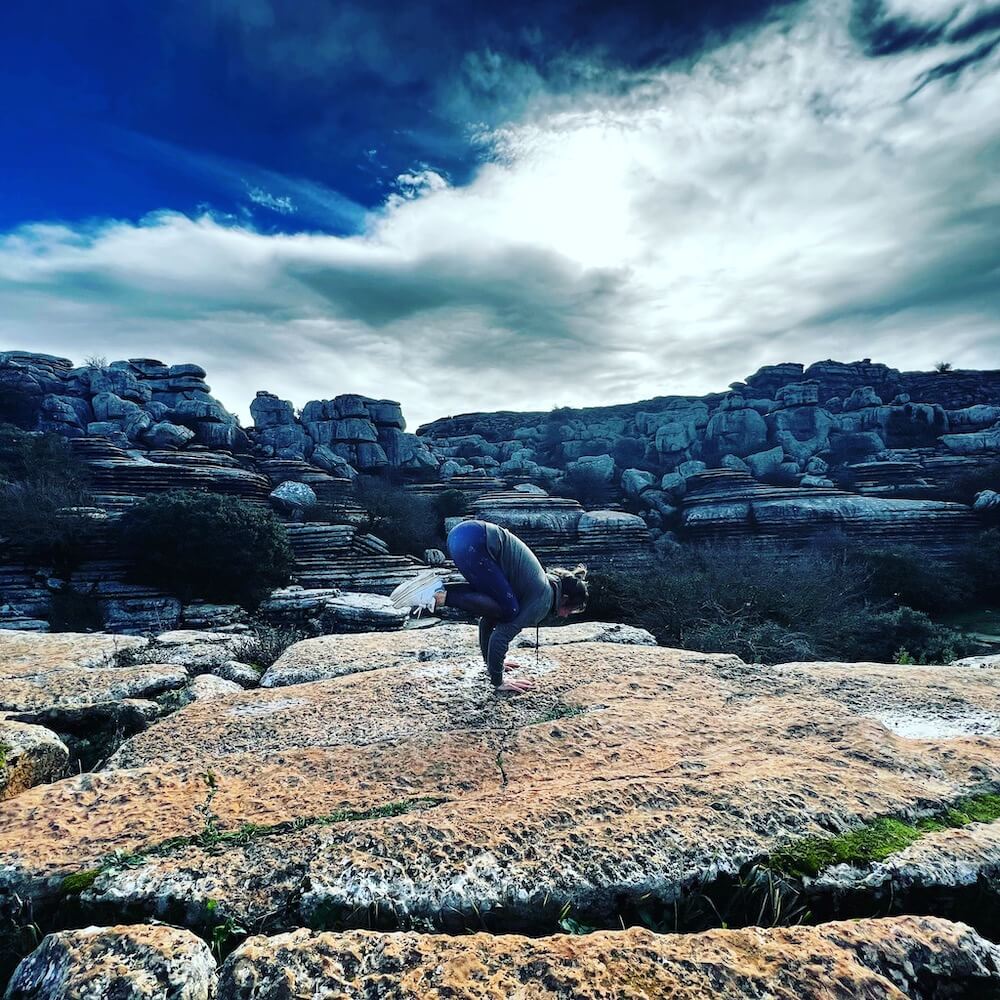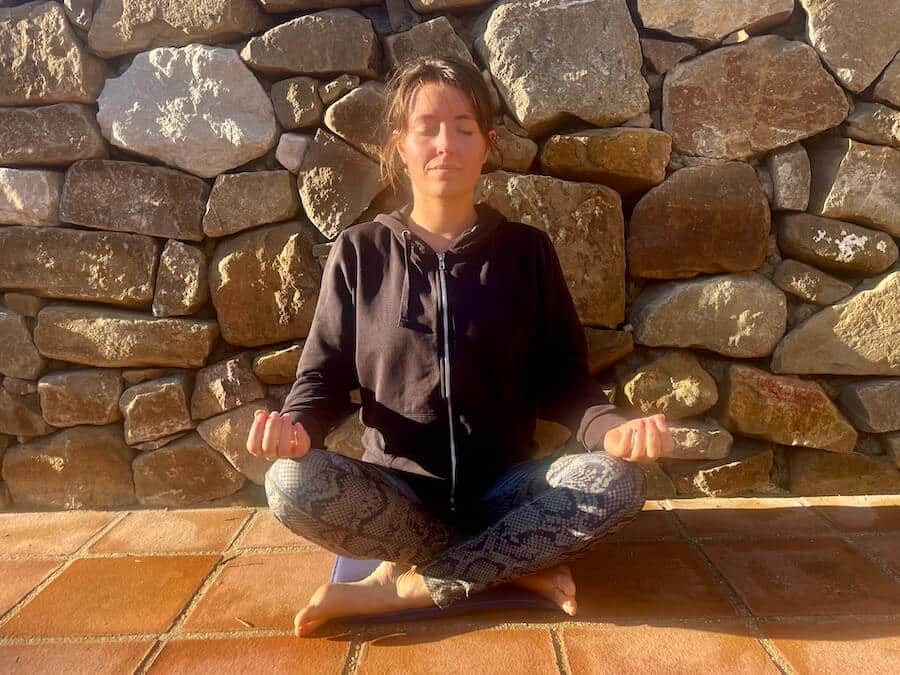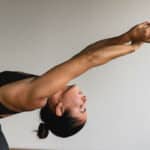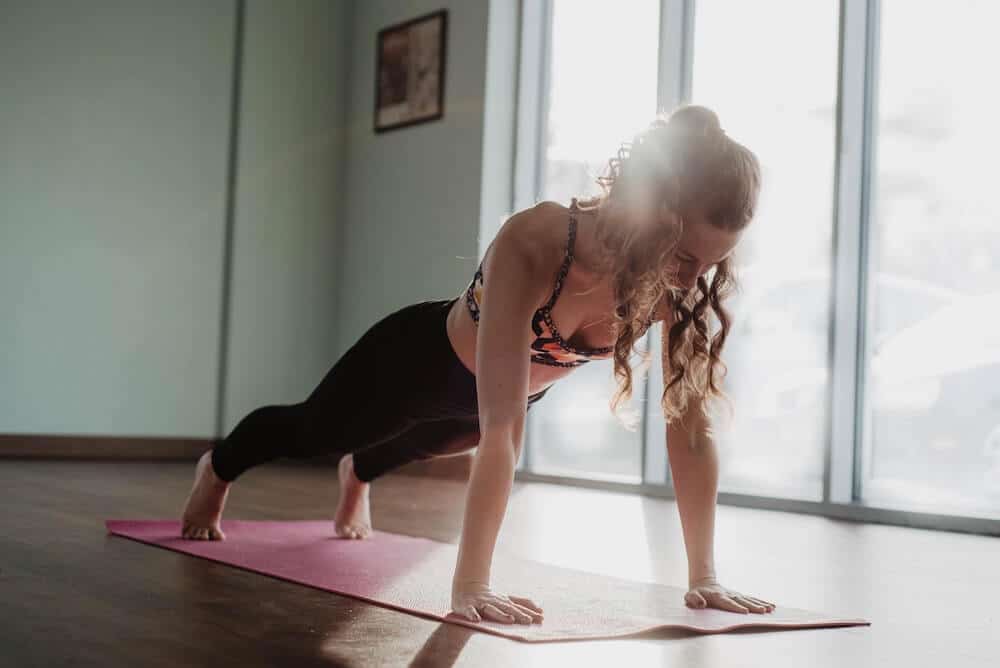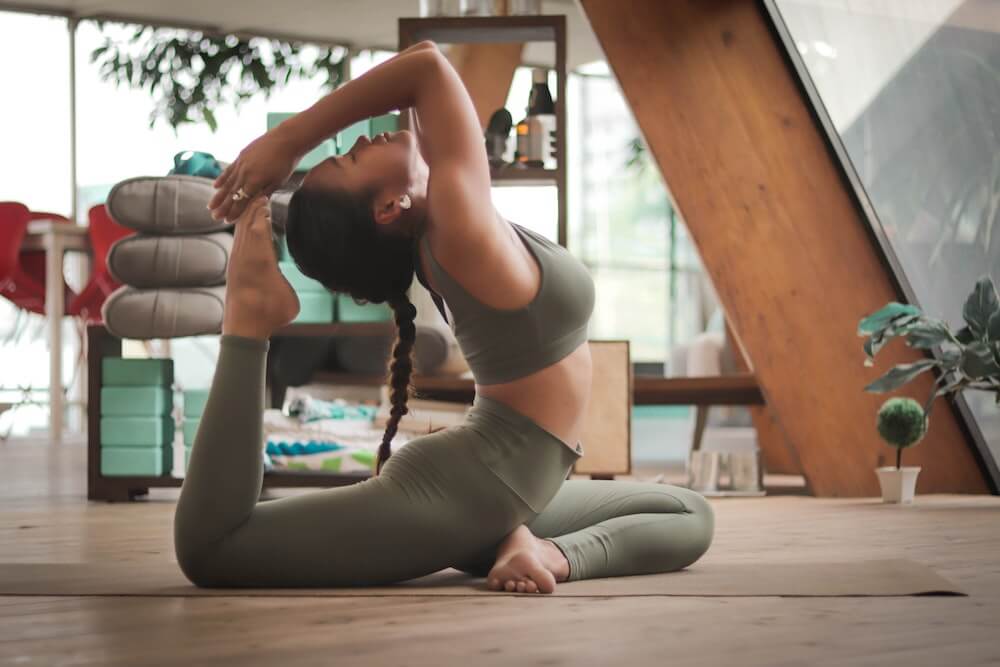Can you learn yoga at home?
The short answer is yes, there are many advantages of learning from the comfort of your own yoga space. And, of course, some disadvantages.
Under any circumstances, it can be hard to get into the habit of practising a new activity, especially when we want to include in our daily life. By doing yoga at home, we can squeeze it in to the most convenient moment of our day.
And if you’ve never done yoga and you’re looking to start learning on your own, it can feel more daunting to set off to a yoga studio.
Or maybe you’ve been to a few classes and want to find a more economical way to learn yoga? Perhaps you’ve already started yoga at home and you’re wondering if you’ll be able to progress in yoga without a live yoga teacher?
Whatever our motivation, learning yoga at home can be an amazing addition to our lives.
And personally for me, it’s how I do yoga. At home. (Though that’s not to say that I’ll never venture out . . . !)
So without further ado, let’s take a look at learning yoga from home. . .
- Why Would You Learn Yoga at Home?
- How Can you Learn Yoga from Home?
- Which Type of Yoga to Choose?
- Choosing an Online Resource for Learning Yoga
- Jessica Richburg Yoga
- How to Learn Arm Balances and Inversions at Home
- How Often Should You Practice Yoga at Home?
- Tips on How to Get the Most out of Your Home Yoga Routine
- Final Thoughts on Can You Learn Yoga at Home?
Why Would You Learn Yoga at Home?
There are so many reasons why learning yoga from home might suit us better than going to a yoga studio. For me personally I love the flexibility of it and the fact that I’m in charge of when, what and for how long I practise on the mat.
On the downside, we take longer to progress and we need some hands on tuition at some point so that we don’t get into bad habits or a plateau situation, repeating the same old flow time again without intentionality for example.
So, here are some pros for doing yoga at home, with the help of a great online teacher and video resources.
Pros of Learning Yoga at Home
- You get to choose what time of day you practise
- You can decide how long a session according to your mood, time and energy levels
- You can choose the style of yoga
- Increase the duration of the yoga sessions gradually over time
- Easily do yoga every day without leaving home
- Enjoy your yoga session as a private, me time
- After yoga you can meditate
- Take yoga out into nature whenever possible
- Practise alone (advantage and disadvantage) without being watched or feeling self conscious
- Save money
Cons of Learning Yoga from Home
- There’s nothing like hands on corrections in yoga
- We can’t learn by seeing others learning
- There’s no social aspect to it
- It may be difficult to find quality videos that resonate with you
- You need to have self-discipline and self-motivation
- It can be difficult to prioritise your yoga session when you have a busy schedule
- You can get into bad habits or practise out of alignment
How Can you Learn Yoga from Home?
So you want to learn yoga at home but you’re not sure of the best way to set about it? The most important things for your yoga practice are your mat and an online yoga platform that fits you.
What You’ll Need
- a yoga mat
- yoga blocks (or books)
- an online teacher with plenty of videos
- comfortable stretchy clothes
There are many different types of yoga to choose from as well as thousands of yoga teachers online.
So we not only have to find the teacher/s who most resonate with us, but also the style/s of yoga which we enjoy the most.
Here is a brief overview of the different types of yoga to choose from.
Which Type of Yoga to Choose?
Hatha Yoga
The word Hatha has many different meanings but in yoga it’s referring to the sanskrit words ha (sun) and (tha) moon, making hatha the balance between the two energy forces.
Hatha yoga focuses on the asanas (poses) and breathing (pranayama). Proper alignment, breathing and meditation are all parts of hatha yoga.
The poses tend to be held for longer and are seen as separate asanas rather than joined together by a flow as in vinyasa for example.
Hatha yoga includes the spiritual, physical and mental aspects of yoga and is a great style of yoga to choose for anyone who’s starting to learn yoga.
Vinyasa Yoga
Vinyasa yoga combines and groups asanas together, with movement between them to create a yoga flow. The flow is then linked to the breathing, which becomes the anchor of the practise.
With the in-breath, you move, with the out breath you move . . . so that each movement and each breath becomes mindful.
Vinyasa is a more active form of yoga and it can include strength, flexibility and cardio. It will often include some sun salutations.
Vinyasa can fit you if you enjoy physical exercise and are looking for perhaps
Power Yoga
Power yoga focusses more on fitness, including strength, cardio and stamina. It will include demanding vinyasa flows, often at a faster pace, as well as core-strengthening movements.
Power yoga isn’t a good place to start out unless you enjoy physical exercise and are already fit.
Ashtanga Yoga
Ashtanga yoga was developed by Sri K. Pattabhi Jois in the early 1900s and is based around a set series of asanas which follows the same pattern each time.
The Primary series is the first series and is a physically challenging flow incorporating standing, sitting and lying poses.
Ashtanga is demanding and not very suitable for beginners without a live yoga teacher to instruct and correct you. It can also become demotivating to follow the same sequence every day on your own at home.
Iyengar Yoga
Iyengar yoga was developed by B.K.S. Iyengar and brought from India to the west in the 1970s. Iyengar yoga focusses on great attention to detail, precision and correct alignment in the asanas.
The asanas are put together in specific sequences but are practised individually and held for longer than other yoga styles to allow the muscles to lengthen and the practitioner to become more aware of the alignment of the pose.
Iyengar yoga also embraces the use of props to help the student remain correctly aligned in asanas where they otherwise would not be able to be.
Iyengar yoga also focuses on uniting the mind, body and soul and is useful also for healing.
Yin Yoga
Yin yoga’s a slower form of yoga where the asanas are passively held for a longer period of time, usually between 3-5 minutes for each asana. In yin yoga we relax into the pose with a passive stretch rather than activation of the muscles, targeting the deep connective tissues of the body, such as the fascia, ligaments and tendons.
It’s restorative, meditative and great for creating more flexibility.
Yin yoga’s a great practise to intersperse with one of the more dynamic styles of yoga or for unwinding after a power/vinyasa flow.
As well as improving flexibility and joint mobility, yin yoga promotes relaxation and stress relief.
Hot Yoga
Hot yoga is practiced in a hot room with high temperatures and humidity. The most famous type of hot yoga, which was founded by Bikram Choudhury, is known as Bikram Yoga. Bikram yoga is practised in a room heated to 41ºc with 40% humidity.
However, the world of Bikram is not what we would come to expect in the yoga world.
In 2019 Netflix released a documentary series exposing Bikram’s court cases and charting the rise and fall of Bikram.
The series revealed the many allegations of sexual assault, fraud, offensive behaviour to women, and rape which were reported by his students. A total of five women sued Bikram for sexual assault and in 2016 he lost a case against a former employee for rape and unlawful dismissal.
Despite this un-yogi history, people still go to Bikram studios to practise hot yoga – but there are other less-known names where hot yoga is practised too.
Given the extreme heat and humidity, hot yoga may not be suitable or even desirable for everyone.
Choosing an Online Resource for Learning Yoga
Picture this: you hop on your mat all smiles and eager for the off, press play on the Youtube video and slide down into child’s pose to begin. Except after 7 minutes on the mat you’ve discovered that this flow really isn’t for you.
We’ve all been there. Especially in the beginning.
We need a yoga teacher who connects with us, motivates and inspires us. So, nobody can tell us who’s the best teacher. But we can share those who inspire us in the hope that they also inspire others.
And here are just a few of the online resources to choose from when you’re starting out with your new yoga routine.
Yoga with Adriene
Yoga with Adriene is a great place to start your yoga journey, and Adriene has a lovely gentle voice.
When starting out, I can’t think of a better place to start than with yoga with Adriene. And by following a 30 day challenge, we keep up the motivation for the entire month because we don’t have to go searching for a new video each day.
And it’s free to join.
Here it is!
I like Adriene’s charisma and personality, and for me, the voice is really important because it can be sooo annoying on some yoga videos, but Adriene’s isn’t.
I like the way she approaches the whole yoga flow and she’s definitely got a smooth way of getting you into yoga and introducing us to various poses.
I would really recommend this as a great starting place for your new yoga journey.
Yoga With Kassandra
I speak a lot about yoga with Kassandra, including in my article about the best way to learn yoga online, because I love Kassandra’s yoga sessions.
She shares a blend of vinyasa with yin (plus some pure yin videos) and you can find as short as 15 minutes to as long as 1 hour flows.
She also offers a 30 minute a day for 30 days flexible body flexible mind yoga stretch for all levels. And it’s also absolutely for free.
And here’s one of Kassandra’s slow burn and stretchy 60 minute flows.
I really recommend yoga with Kassandra as a great resource for learning yoga from home.
Jessica Richburg Yoga
Another Youtube Yogi channel with tons of gorgeous flows, including vinyasa flows as well as more mindful yin and restorative yoga routines is Jessica Richburg yoga.
Jessica has 20 minute videos to 1 hour videos.
How to Learn Arm Balances and Inversions at Home
If you’re already practising yoga flows and looking for something new, you may be hungry to take it to the next level.
In that case, I can’t tell you how much I appreciate having joined Yogi Flight School because it takes my yoga to the next level. If you like the idea of a challenge made fun, go for it.
Yogi Flight school isn’t a free course but they do offer a free workshop so that you can test the waters before committing.
In fact I like it so much, I wrote a whole Yogi Flight School review.
How Often Should You Practice Yoga at Home?
Honestly? Every day.
Every day turns into every-day-that-something-doesn’t-pop-up-to-stop-you. It sets the right intention. It gets you into the groove.
You can do yoga as much as fits into your lifestyle, but the only way to get true transformation so that yoga becomes part of your roots (in my opinion) is to practise every day, or at least almost every day.
Only when yoga truly becomes a part of your life do you really feel the deep benefits. But having said that, you can fall in love with once a week, if once a week is all you can manage right now.
On the days when you don’t do yoga, do a quick mini-yoga, a downward facing dog, spinal twist or plank pose before you start your day. By just including that little moment, you’ll remind your mind of your yoga practice and make it easier to keep it going.
It’s so easy to fall in and out with yoga. It’s as though you cross a line into it and you’re full speed ahead.
Then you cross one little line out of it and it becomes a thing of the past, until your next wave of practice comes your way. So to avoid that, do those little stretches, or invent your own short yoga flow to squeeze into your day when you get out of bed.
It might take you a few years to really feel that yoga’s part of your life (as it did me), but if you know where you’re going, it doesn’t matter how long it takes, you just keep going.
How Long Will it Take to Improve in Yoga?
It depends on how often and for how long, and how hard you apply yourself to your yoga sessions.
But if we change the question to, how long will it take to feel the benefits of yoga? Then the answer is immediately.
Yoga brings so many benefits, both while you’re in the flow and after you’ve finished. There’s nothing in this world to replace the feeling of connecting with your body, mind and soul in a yoga flow.
But progress on the yoga mat, especially in the physical asanas, is also important for our motivation and satisfaction.
Tips on How to Get the Most out of Your Home Yoga Routine
- Choose a yoga flow to fit your mood each day.
- Always, always congratulate yourself on showing up on the mat.
- Link your yoga flow to the breath and practise pranayama.
- Dedicate yourself to the journey and accept where you are in your practise.
- Choose the best time to get on the mat to fit into your daily schedule and be prepared to vary it if necessary.
- Don’t compare yourself to others. We all have our own weaknesses and strengths. Your weaknesses are what ultimately make you strong. Appreciate them as a way to learn.
- Try to vary your yoga so that you keep surprising your body.
- Enjoy and give gratitude.
Final Thoughts on Can You Learn Yoga at Home?
If you’ve flirted with the idea of taking up yoga, don’t put it off any longer. Get yourself a yoga mat, strip off into some comfy leggings and hop onto the mat for some serious me time.
You won’t regret it, I promise.
